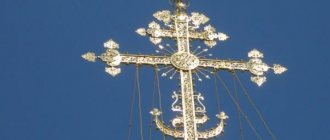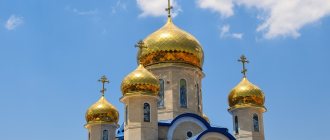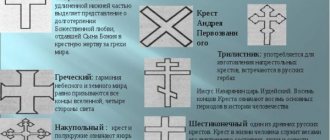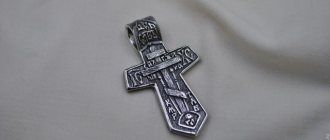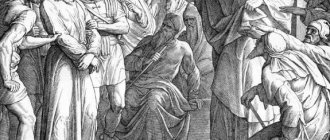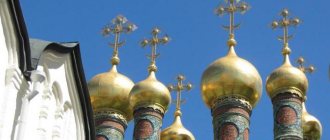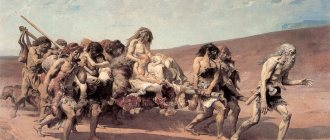Gospel narrative
The abbreviation is depicted on the title of the crucifix, above the image of Christ. According to the New Testament, the phrase was originally written by Pontius Pilate on the cross on which Christ was crucified:
| Pilate also wrote the inscription and placed it on the cross. It was written: Jesus of Nazareth, King of the Jews. This inscription was read by many of the Jews, because the place where Jesus was crucified was not far from the city, and it was written in Hebrew, Greek, and Roman. The chief priests of the Jews said to Pilate: Do not write: King of the Jews, but what He said: I am the King of the Jews. Pilate answered: What I wrote, I wrote. |
The inscription was made in three languages: Hebrew (the language of the local population), Greek (the international language of communication at that time) and Latin (the language of the Romans; Palestine was then a Roman province, the governor was Pontius Pilate).
What does the inscription NIKA and other inscriptions on the Orthodox Cross mean?
Appeal to the power of the Life-giving Cross of the Lord is a great protection for every person. It is known that the sign of the cross stops the demonic influence: the devil and his servants cannot bear the correct cross, so they often try to mock it (this is precisely the origin of the satanic symbols of the inverted cross).
The cross is an important symbol for every Orthodox Christian. This is the power of God, visibly abiding with us, on our body, from Baptism itself. Therefore, it is especially important to have an Orthodox Cross at home, correctly depicted on an icon consecrated and purchased in the temple or made in metal.
On the Orthodox Cross you can often see a number of inscriptions and additional images that seem mysterious to the uninitiated person: NIKA, skull, IS XC CI. Our article will explain their meaning.
Links
Useful
See what “INCI” is in other dictionaries:
INCI - Jesus the Nazarene, King of the Jews Bible ... Dictionary of abbreviations and abbreviations
incision - incision, and ... Russian word stress
Lu Yingqi - In this Chinese name, the surname (Lu) comes before the personal name. Lu Yingqi 盧映錡 Personal information Gender: female Nationality ... Wikipedia
Incipit - (Latin incipit begins, personal form of the verb incipere)[1] the initial one or more words of any text, which serve to identify it, and also perform the function of its name (heading). In medieval Latin manuscripts ... ... Wikipedia
Pećinci — Infobox Serbia municipality native name = Pećinci|official name=Pećinci mayor = Nikola Pavković district = Srem area km2 = 489 population total = 2659 mpop = 21506 settlement type= Village latd = 44| latm = 54|longd = 19| longm = 58 code = 22... ... Wikipedia
Gospođinci - (Gospođinci) is a village in the municipality of Žabalj, in the South Bačka District of Serbia. It is located in the Autonomous Province of Vojvodina. The village has a Serb ethnic majority and its population is 3,896 (2002 census).NameIts name… … Wikipedia
WANG YANMING SCHOOL - Yangming xue pai. According to the founder of Chinese historical and philosophical science, Huang Zongxi (17th century), the closest followers of Wang Yangming (late 15th and 16th centuries) formed six territorial groupings: 1) Zhejiang (Zhezhong); 2) Jiangxi (Jiang... ... Collier's Encyclopedia
Opština Pećinci - Pećinci Pećinci ... Deutsch Wikipedia
Bajinci (Crna Trava) - Pour les articles homonymes, voir Bajinci. Bajinci Administration Pays … Wikipédia en Français
Drajinci - Drajinci, Drajinci Administration Pays ... Wikipédia en Français
Source
What does INRI mean over the crucifixion of Jesus, and why did the Russians write in their own way?
Receive one of the most read articles by email once a day. Join us on Facebook and VKontakte.
However, for many of us, the crucifixion is associated with only one historical event - the execution of Jesus Christ, who of his own free will took upon himself the guilt of all people and suffered a shameful and martyr's death for it.
Until then, the Son of God, who loves all people, the entire human race, will ascend to Calvary and be crucified in the name of the salvation of our souls. Therefore, each of us has a spark of God and we all walk with it in our hearts, both believers and non-believers. And we all thirst for love and kindness.
Additional symbolism
As additional symbols on the crucifix you can see the following:
A semicircle at the foot of the cross, sometimes designated by the letters "GG". He identifies Mount Golgotha, as evidenced by the abbreviation. Here you can often see a skull with two crossed tibia bones. Symbolically it means Death accepted on the cross. But there is another explanation for these sacred symbols. Since it is on Golgotha that the remains of the first people - Adam and Eve - rest, the flowing blood from the wounds of Christ washes away their original sin and cleanses all humanity from it. The inscription “HA” next to the bone remains means “Head of Adam”.
Two diagonal lines diverging from the base of the cross. Symbolically, they mean the spear with which the Roman warrior Longinus inflicted a wound in the chest of the martyr hanging on the cross, but did not reach his heart, and the staff on which Jesus leaned while carrying a heavy burden (the crossbar from the cross) to Golgotha. On both sides of these diagonal lines you can sometimes read the letters “K” and “T” - the first letters in the name of the passionate weapons - spears and canes.
The bottom crossbar is usually beveled. According to the Gospels, two thieves died on Calvary along with Christ. During his lifetime, one of them believed in the Savior and repented of his sins. The second one spoke disparagingly about Jesus. Therefore, the crossbar raised upward indicates that Dismas, the prudent robber, followed Jesus to Heaven, and Gestas, the mad robber, followed to Hell.
The image of the Savior in Orthodoxy and Catholicism
In the Orthodox interpretation of the crucifixion, the image of Christ remained triumphant. On the cross, he “does not die, but freely stretches out his arms, his palms are open, as if he wants to embrace all humanity, giving them his love and opening the way to eternal life.”
In the Catholic crucifix, the image of Christ is much more realistic. It depicts Jesus dead, and sometimes with streams of blood on his face, from wounds on his arms, legs and ribs. The iconography reveals all the suffering of a tortured person and the torment that the Son of God had to experience. There are traces of unbearable pain on his face, his arms sagged under the weight of his body, which is very believably curved.
On the Catholic cross, Christ is dead, there is no triumph of victory over death, that triumph that we see in Orthodox iconography.
The cross accompanies a Christian all his life; he sees it in churches and wears it on his chest as protection. Therefore, everyone will be interested in learning about the meaning of the abbreviation on the title of the crucifixion.
As is known from the Holy Scriptures, Pontius Pilate could not find any other way to describe the guilt of Christ, so the words “Jesus of Nazareth, King of the Jews” appeared on the tablet.
Over time, this inscription in iconography was replaced by an abbreviation. In Latin in Catholicism this inscription looks like INRI, and in Orthodoxy it looks like IHCI (or ІНВІ, “Jesus of Nazareth, King of the Jews”).
The crucifix has several more abbreviations: above the middle crossbar there are inscriptions: “IC” “XC” - the name of Jesus Christ; and under it: “NIKA” - Winner.
Monograms of Christ
Monograms of Christ
Monograms of Christ (sacred monograms) of two or more Greek and Latin letters appeared at the very beginning of the development of Christian art.
Monogram XP (Chi-Ro).
The first and most famous of the monograms of Christ is considered to be XP (Chi-Rho), or Christogram, which is the first two letters of the Greek spelling of the name Christ: “chi” and “rho”. Both of these letters have complete graphic and phonetic analogues in the Russian alphabet.
This monogram symbolizes Christ himself, his protection and his victory over death. For some time, the Christogram was the second most important emblem of Christianity, after the fish. After Constantine the Great, the first Roman Christian emperor, came to power in 306, the Christogram took the place of the eagle on Roman standards. As Eusebius, the emperor’s biographer, writes, Constantine finally accepted the new faith after seeing a sign in the sky in which the Christogram appeared against the background of the Sun - a fact that explains Constantine’s perception of Christ as the incarnation of the Sun.
According to another legend, this sign appeared to Emperor Constantine in a dream, and a voice told him: “With this sign you will win.” The Roman battle banner depicting this sign is called Labarum. The Sign of Chi Rho is also called Signum Dei.
After Emperor Constantine approved this symbol as an emblem for his standard, it became the official and most widely accepted symbol of Christianity, and by extension a symbol of victory and triumph, until the image of the cross began to replace it after the fall of the Roman Empire in the 5th century. . Thus, the Chi-Rho monogram as a Christian symbol is older than the cross.
Interestingly, the Christogram existed even before Christianity: in Greek, the word “chrestos” literally meant “auspicious” and also began with X and P; a similar monogram was used even earlier by the Chaldeans as a symbol of the Sun. Both the sign XP (Christ) and sign IX (Jesus Christ) were used by early Christians as mourning monograms.
In various forms, the XP monogram is found in catacombs and tombs, where worshipers hid from persecution. Archaeologists find this sign on coins, lamps, clay shards, and tombstones.
Jesus Christ - "Alpha and Omega".
An auspicious monogram is also considered to be a combination of the letters "alpha" and "omega" - the first and last letters of the Greek alphabet, which the early Christians used to signify the omnipotence and infinity of God, as recorded in the Apocalypse: "I am Alpha and Omega, the beginning and the end, First and last". One option is to place these two letters together with Chi-Rho in a circle - a symbol of eternity. Often “omega” was depicted in capital, and straightened, easier to write, so that sometimes “alpha” was paired with “tau” - the last letter of the Hebrew alphabet.
The monogram “Alpha and Omega” symbolizes the eternity of Jesus Christ; it also refers to the beginning of Christmas Eve, as if saying that the Son of God entered time and space, becoming a Man.
Monogram IXΘYƩ
. Fish, in Greek ixƟýσ, was used as a symbol of Jesus Christ already in the 1st century, and not because fish often appears in the earthly life of Jesus, not because Jesus commanded his apostles to be fishers of human souls (literally: spiritual fishermen), using the Gospel network, but because the word ixƟýσ can be considered as an abbreviation. The word consists of five letters of the Greek alphabet i, x, Ɵ, ý, σ. All of them are the first letters of words that together make up the Christian statement “Jesus Christ is the Son of God, the Savior.”
Apparently the symbol ixƟýσ was a sign by which early Christians recognized each other, especially during persecution. Scratched on a wall, on the floor of a market square or near a fountain, in crowded places, it allowed wandering Christians to find out where their brothers in the faith were gathering. In religious painting, there is such a plot: a person draws an image of a fish in front of him on the sand, thereby making it clear to another who he is.
Monogram IHƩ
. A monogram often decorating vestments, robes, banners, etc. It consists of the first three letters of the word IHƩΘYƩ, that is, Jesus.
IHS Monogram
. A later monogram of Christ. With the decline of Greece in the Middle Ages, monograms made of Latin letters began to appear, often in combination with a cross.
Among the various interpretations of this symbol, the most famous are the following: “In Us Salus” - “In this (the cross) is salvation”; “Iesus Hominum Salvator,” which translates to “Jesus, savior of mankind; “In Hoc Signo” (Vinces) - “With this you will win.” The last expression was presumably addressed to the Emperor Constantine; such an inscription accompanied the sign of the cross, shown to him in a vision before the battle, at the end of which Christianity became the official religion of the Roman Empire. In Germany, a widespread interpretation is: “Jesus Heil und Seligmacher” - “Jesus the Savior and Redeemer.”
Sometimes the IHS monogram is placed in the circle of eternity, in the image of the Sun. This symbol recalls the name that Malachi called the Messiah - “Sun of Righteousness.”
In all cases, the IHS monogram symbolizes salvation or resurrection.
Images of these three letters are widespread, and this suggests that this inscription belongs to the magical tradition and apparently has nothing to do with the Latin interpretations cited above. In fact, it was originally not a Latin phrase at all, but a Greek construction - these three letters were said to be the first letters of the Greek version of the name of Jesus - IHS. However, by the eighth century these letters were considered to belong to the Roman alphabet - IHSous.
In the magical tradition, the upright letter I has the meaning of a central column, symbolizing an upright, righteous person, a person seeking harmony, or wisdom, or initiation, etc. Therefore, when this symbol relates to a human being, the letter I represents a person who, standing face to face with the created world, is in harmony and balance. This explains, in particular, why in the Latin version the letter I was taken as an abbreviation for the word Jesus, which is the archetype of an upright man. In some magical systems, the letter I denotes the human spinal cord.
The letter N (regardless of whether it is Greek or Latin) represents the polarity of life - two opposing principles (light and darkness, good and evil, angelic and demonic, etc.), the conflict between which must be resolved.
The letter S in the IHS monogram symbolizes the harmonization of opposing poles in the human soul (characterized by the letters I and H) and the acquisition of wisdom (the letter 8 looks like a curved snake, which symbolizes wisdom).
The INRI monogram is often used in various mottos and is also the emblem of the Christian orders of the Jesuits, St. Teresa and St. Bernardine of Siena.
Although this monogram is now depicted on the cover of the Bible, on altar covers and on knee pads, its meaning and origin remains unclear to many people, so it is often considered a mysterious sign.
Monogram INRI
. This abbreviation is made up of the Latin words: “Iesus Nazarenus Rex Iudaeorum” - “Jesus of Nazareth, King of the Jews.” Pilate, wanting to expose Jesus to ridicule, ordered this inscription to be inscribed on the titulus (the plaque on the cross for the name) in Latin, Greek and Hebrew: Latin for the Romans, Greek for foreigners and travelers, and Hebrew for the locals residents. Therefore, in Christian symbolism it is sometimes given in three languages.
Over time, the letters INRI began to be depicted on a scroll attached to the top of the cross.
INRI
- a well-known symbol of suffering.
"Jesus of Nazareth, King of the Jews"
INRI monogram attached to a cross
Other monograms of Christ
| In this sign, the fish is a symbol taken from the very early period of Christianity. | The sign of Christ composed of an "I" and the Greek letter "X" |
| The double cross is an early Christian symbol consisting of the Greek letter "X" and a cross. | A very ancient pagan solar disk, which was interpreted by Christians as a sign of Christ: “i” - Jesus, “X” - Christ |
| The sign of Christ taken from the mosaics in the catacombs. Made in three different formats, superimposed on one another | Combination of the sign of Christ with “I” and “C” (Jesus Christ, Savior) |
| Here the Greek letter "P" (rho) is replaced by the Latin "K" | Hidden sign of Christ. Considered as the intersection of four "X's" |
| The line above the monogram means the Holy Spirit | Monogram of Christ. Old sign of the Savior, or Holy Spirit |
| The sign of Christ, reminiscent of the Egyptian cross - ankh | According to one theory, the "omega" at the bottom of the rose is read as "5", then the sign means "Rosa Rosarum" - one of the names of the Virgin Mary |
| The sign of Christ along with the Greek word for fish | This symbol originally appeared on Greek communion wafers. It means "Jesus Christ the Conqueror" |
| The sign of Christ, in which the Greek letter "P" is replaced by a hook. Here instead of “X” we get a cross | |
| These two signs represent a further development of the previous sign of Christ | |
| The interpretation of this cross is as follows: “Christ, symbolized by the cross, born of Mary, symbolized by the crescent” | |
More material on this topic
Colonies of Atlantis Sumer Edgar Cayce The Secret Emperor Grigory Rasputin Birth and the laws of karma
Classic fortune telling runes
Included with the set you will find a complete interpretation of the runes, as well as various ways of arranging these unique signs.
Universal Tarot Cards
A deck of these cards is suitable for both those who are just learning the secrets of the tarot, and those who are already familiar with fortune telling using such cards.
← all articles

